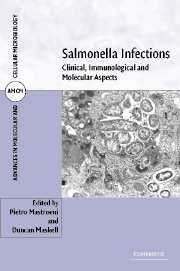Book contents
- Frontmatter
- Contents
- List of contributors
- Preface
- 1 Epidemiological and clinical aspects of human typhoid fever
- 2 Antibiotic resistance in Salmonella infections
- 3 Host-specificity of Salmonella infections in animal species
- 4 Public health aspects of Salmonella enterica in food production
- 5 The Salmonella genome: a global view
- 6 Pathogenicity islands and virulence of Salmonella enterica
- 7 In vivo identification, expression and function of Salmonella virulence genes
- 8 Mechanisms of immunity to Salmonella infections
- 9 Interactions of S. enterica with phagocytic cells
- 10 Interactions between Salmonella and dendritic cells: what happens along the way?
- 11 Immunity to Salmonella in domestic (food animal) species
- 12 Newer vaccines against typhoid fever and gastrointestinal salmonelloses
- 13 S. enterica-based antigen delivery systems
- Index
- Plate section
- References
8 - Mechanisms of immunity to Salmonella infections
Published online by Cambridge University Press: 04 December 2009
- Frontmatter
- Contents
- List of contributors
- Preface
- 1 Epidemiological and clinical aspects of human typhoid fever
- 2 Antibiotic resistance in Salmonella infections
- 3 Host-specificity of Salmonella infections in animal species
- 4 Public health aspects of Salmonella enterica in food production
- 5 The Salmonella genome: a global view
- 6 Pathogenicity islands and virulence of Salmonella enterica
- 7 In vivo identification, expression and function of Salmonella virulence genes
- 8 Mechanisms of immunity to Salmonella infections
- 9 Interactions of S. enterica with phagocytic cells
- 10 Interactions between Salmonella and dendritic cells: what happens along the way?
- 11 Immunity to Salmonella in domestic (food animal) species
- 12 Newer vaccines against typhoid fever and gastrointestinal salmonelloses
- 13 S. enterica-based antigen delivery systems
- Index
- Plate section
- References
Summary
INTRODUCTION
Salmonella enterica affects humans and animals worldwide. It can be found in sewage-, sea-, and river- water and can contaminate food. Asymptomatic carriage in domestic animals can result in the introduction of the bacteria into the food chain.
Interest in understanding the mechanisms of pathogenesis and immunity that operate in S. enterica infections is twofold. Firstly, development of vaccines against salmonellosis has been too empirical due to insufficient understanding of how the host controls these infections, and how the bacteria evade immune surveillance. The fact that S. enterica-based vaccines are also being evaluated as systems to deliver recombinant antigens or DNA vaccines to the immune system and as new tools for the therapy of cancer has further increased the need to study how these vaccines work (Chabalgoity et al., 2002; Mastroeni et al., 2001; Reisfeld et al., 2004).
Secondly, S. enterica provides a model to understand how bacterial pathogens interact with the immune system. S. enterica is an intriguing bacterium in the way it interacts with the immune system and the immunological requirements for host resistance to this bacterium are affected by a very large number of variables.
MODELS FOR THE STUDY OF IMMUNITY TO S. ENTERICA
The study of the immunobiology of S. enterica infections has been facilitated by the availability of reliable models and by improved genetic tools that allow identification of polymorphic differences or mutations in genes involved in immune functions.
- Type
- Chapter
- Information
- Salmonella InfectionsClinical, Immunological and Molecular Aspects, pp. 207 - 254Publisher: Cambridge University PressPrint publication year: 2006
References
- 2
- Cited by



